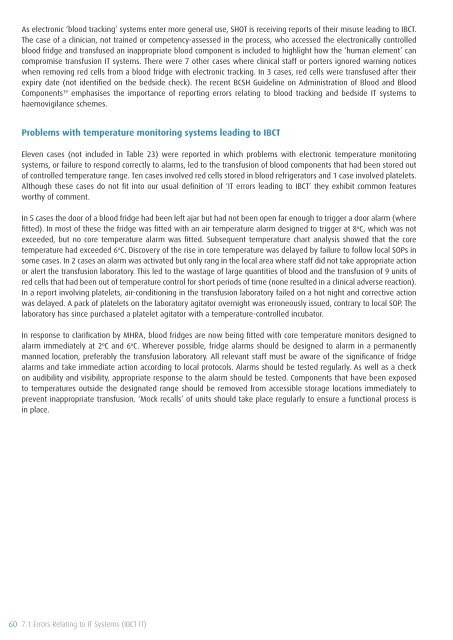SHOT Annual Report 2009 - Serious Hazards of Transfusion
SHOT Annual Report 2009 - Serious Hazards of Transfusion
SHOT Annual Report 2009 - Serious Hazards of Transfusion
You also want an ePaper? Increase the reach of your titles
YUMPU automatically turns print PDFs into web optimized ePapers that Google loves.
As electronic ‘blood tracking’ systems enter more general use, <strong>SHOT</strong> is receiving reports <strong>of</strong> their misuse leading to IBCT.<br />
The case <strong>of</strong> a clinician, not trained or competency-assessed in the process, who accessed the electronically controlled<br />
blood fridge and transfused an inappropriate blood component is included to highlight how the ‘human element’ can<br />
compromise transfusion IT systems. There were 7 other cases where clinical staff or porters ignored warning notices<br />
when removing red cells from a blood fridge with electronic tracking. In 3 cases, red cells were transfused after their<br />
expiry date (not identified on the bedside check). The recent BCSH Guideline on Administration <strong>of</strong> Blood and Blood<br />
Components 19 emphasises the importance <strong>of</strong> reporting errors relating to blood tracking and bedside IT systems to<br />
haemovigilance schemes.<br />
Problems with temperature monitoring systems leading to IBCT<br />
Eleven cases (not included in Table 23) were reported in which problems with electronic temperature monitoring<br />
systems, or failure to respond correctly to alarms, led to the transfusion <strong>of</strong> blood components that had been stored out<br />
<strong>of</strong> controlled temperature range. Ten cases involved red cells stored in blood refrigerators and 1 case involved platelets.<br />
Although these cases do not fit into our usual definition <strong>of</strong> ‘IT errors leading to IBCT’ they exhibit common features<br />
worthy <strong>of</strong> comment.<br />
In 5 cases the door <strong>of</strong> a blood fridge had been left ajar but had not been open far enough to trigger a door alarm (where<br />
fitted). In most <strong>of</strong> these the fridge was fitted with an air temperature alarm designed to trigger at 8 o C, which was not<br />
exceeded, but no core temperature alarm was fitted. Subsequent temperature chart analysis showed that the core<br />
temperature had exceeded 6 o C. Discovery <strong>of</strong> the rise in core temperature was delayed by failure to follow local SOPs in<br />
some cases. In 2 cases an alarm was activated but only rang in the local area where staff did not take appropriate action<br />
or alert the transfusion laboratory. This led to the wastage <strong>of</strong> large quantities <strong>of</strong> blood and the transfusion <strong>of</strong> 9 units <strong>of</strong><br />
red cells that had been out <strong>of</strong> temperature control for short periods <strong>of</strong> time (none resulted in a clinical adverse reaction).<br />
In a report involving platelets, air-conditioning in the transfusion laboratory failed on a hot night and corrective action<br />
was delayed. A pack <strong>of</strong> platelets on the laboratory agitator overnight was erroneously issued, contrary to local SOP. The<br />
laboratory has since purchased a platelet agitator with a temperature-controlled incubator.<br />
In response to clarification by MHRA, blood fridges are now being fitted with core temperature monitors designed to<br />
alarm immediately at 2 o C and 6 o C. Wherever possible, fridge alarms should be designed to alarm in a permanently<br />
manned location, preferably the transfusion laboratory. All relevant staff must be aware <strong>of</strong> the significance <strong>of</strong> fridge<br />
alarms and take immediate action according to local protocols. Alarms should be tested regularly. As well as a check<br />
on audibility and visibility, appropriate response to the alarm should be tested. Components that have been exposed<br />
to temperatures outside the designated range should be removed from accessible storage locations immediately to<br />
prevent inappropriate transfusion. ‘Mock recalls’ <strong>of</strong> units should take place regularly to ensure a functional process is<br />
in place.<br />
60 7.1 Errors Relating to IT Systems (IBCT IT)












